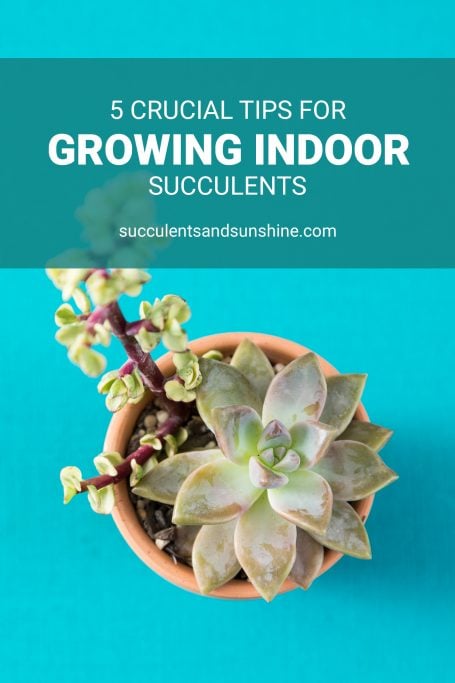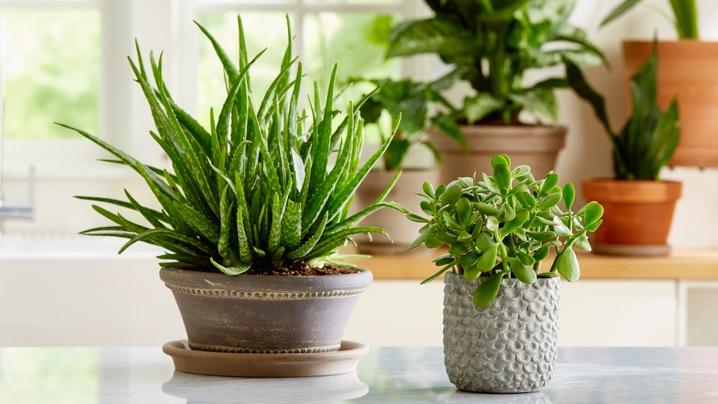Taking care of indoor succulents can be challenging, but with these tips it is easier to maintain a flourishing collection.
Despite their charming appearance, succulents are not always the best choice for indoor house plants.
However, it is still worth giving them a try!
This post will provide you with step-by-step instructions on how to cultivate lovely, vigorous succulents inside your home.
If you want to get the most out of this advice, you should check out my free cheat sheet on succulent watering. It will show you exactly when to give them more or less water. Click the link to get the cheat sheet, it’s sure to be useful.
Notice: Please be aware that some of the links on this page could be affiliate links, meaning I get a commission (without any additional cost to you) when you click on the link and make a purchase. Unless otherwise mentioned, I only suggest products that I have personally used and enjoyed.
Table of Contents
Start with the right succulents
Not all succulents are suitable for indoor cultivation. To ensure the best chance for success, select plants that prefer shaded or dimly lit areas rather than full sun.
Visit this link to browse a selection of outstanding indoor succulents from our preferred supplier.
Generally, succulents with vibrant hues (e.g. red, purple and orange) are not suitable for indoor settings as they need direct sunlight which is usually not available in interior spaces.
Beginning with succulent plants that have a natural green hue is a smart option. Two examples of such succulents are Haworthia and Gasteria, which are illustrated in the following images.
This short video will show a few of my favorite succulents that are suitable for indoor growing.
As much light as possible
Succulents kept inside may have difficulty receiving enough sunlight, as they generally require around 6 hours of bright, indirect light when planted outdoors.
In lieu of natural light, place your succulents close to the brightest window or area of your living space if possible. If you don’t have a window that receives light all day, find the brightest spot in your home or office and place your succulents there.
Gain additional knowledge by viewing this video.
Water more, but less frequently
Having succulents in your home is a significant undertaking, as they require more water than you may think. Nevertheless, it’s important to not over-water them and to instead follow a less frequent watering schedule than normal houseplants.
succulents don’t need an abundant amount of water, but they still require it.
In other words, succulents don’t need to be watered consistently or frequently, but they do still need some water to survive.
Succulents require a regular cycle of being watered, then allowed to dry out before being watered again. The soil should be dry for a few days before watering the roots to ensure optimum hydration.
To ensure that succulents thrive, it is best to use the “soak and dry” method, which is more effective than simply giving them a light misting with water.
Avoid watering houseplants that are succulents too frequently; this is a surefire way to kill them.
Understand that succulents typically experience a period of inactivity during the colder months of the year, when they don’t require as much hydration as they do during their active growing season. As they are not actively growing, they won’t use up as much water.
Many people believe their succulents are in trouble when they notice the lower leaves wilting and shrinking. However, it is perfectly normal for these leaves to eventually die off, just as is the case with all plants.
You should only worry about dying leaves if the most recent or highest leaves on your succulent are wilting. If the leaves near the bottom of the stem (closest to the soil) are affected, there is no need for concern.
If you haven’t already, don’t forget to get my free cheat sheet to check when your succulents need more or less water. Click here to access the cheat sheet.
Avoid Glass Containers (or anything that doesn’t drain)
Glass containers are not suitable for planting succulents in the long term since they can lead to soggy soil. This is because glass jars or terrariums do not have an outlet for excess water to escape, which can be detrimental to the health of the succulent.
Another drawback of using glass containers for succulents is that they don’t provide adequate air circulation. Succulents require adequate airflow for their roots to remain healthy, which in turn keeps the stems and leaves healthy.
If you are determined to plant your succulents in a glass container you have a special fondness for, read this post to discover how to water succulents in containers without drainage.
I would suggest avoiding glass containers for your succulents unless you have a good understanding of their needs and are confident in your watering ability. If you’d like to learn more about why I prefer terra cotta and glazed ceramic pots for indoor plants, please click the link!
You can purchase a wide assortment of pots with drainage holes from Mountain Crest Gardens and Etsy that are both affordable and provide excellent airflow, allowing the soil to dry out more quickly.
Bugs
If you adhere to the necessary care requirements for keeping succulents healthy as indoor house plants (watering, soil, light, air circulation, etc.), you typically won’t encounter issues with bugs.
In other words, if you inadvertently purchase a plant that has bugs, it can quickly become a major problem.
A common issue that novice gardeners experience is gnats. These pests are usually caused by soil that stays too moist, but they can be avoided by using a soil mixture that drains well and allowing the soil to dry out between watering.
Mealybugs are a common nuisance that can wreak havoc on succulents. These small, white pests attach themselves to the plants and are difficult to remove.
If you’re dealing with mealybugs, you should spray them with rubbing alcohol and pour some over the soil to kill any eggs. For more information on how to treat these pests, click here.
Have fun!
The beauty of having succulents indoors is that even if you are not very skilled in keeping them alive, their appearance will stay pleasing for a good while.
I hope you now feel confident in your ability to care for your succulents indoors! Keep your stress levels in check. Remember, succulent gardening is meant to be enjoyable and calming.
If you’re looking for an easy way to learn about some of the best succulents to grow indoors, watch this video.
FAQ
Where should succulents be placed indoors?
Put the potted succulent in an area that will get good sunlight. It is best to choose a spot near a south- or east-facing window that will give the plant 6 hours of sunlight each day. If the succulent does not get an adequate amount of light, you may observe it stretching out in an effort to reach the sun.
How do you keep succulents healthy indoors?
Succulents don’t want to be sitting in a saucer of water so make sure you don’t over water them. Put them in well-draining soils and only water when the soil is dry.
Rewording:
– Position your succulents near a window for optimal light. Also, be sure to provide plenty of air circulation to keep pests away. Lastly, make sure the soil is well-draining and only water when the soil is dry to prevent root rot.
How often should you water succulents?
But succulents, on the other hand, want to be kept on the drier side of things.
The key to watering succulents correctly is to wait until the soil in the pot is completely dry. Make sure the dirt is crumbly, not moist, before you water again. This is different than how to care for many other houseplants, which require their soil to stay moist. Succulents, however, prefer to stay on the drier side.
How often do you water indoor succulents?
It is recommended to water your succulents every two weeks during non-winter months when temperatures are above 40 degrees. However, during the colder months when temperatures are below 40 degrees, you should only give them water once a month since they become dormant at this time. There may be a few exceptions to this rule.
Do succulents need direct sunlight?
If you want to keep succulents in your home, it is best to give them bright direct sunlight for about 6 hours a day. However, if you don’t have any sunny spots, try opting for plants like mother-in-law tongue that thrive in dimmer areas. Position these plants near a window that faces south or east for maximum light exposure.


